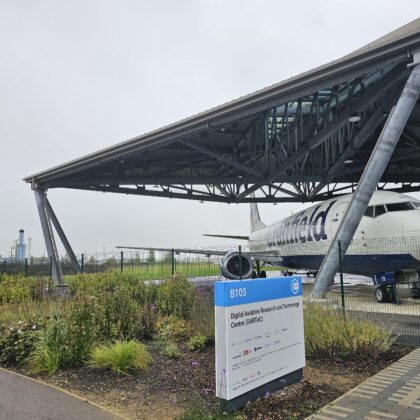Best practices in the use of an airborne teaching laboratory
The Aeronautical Journal September 2023 Vol 127 No 1315
Introduction
Steven Daniels, Guy Gratton and Graham Braithwaite introduce the paper: Establishing best practices in the use of an upgraded airborne teaching laboratory.
The ‘flying classroom’
The National Flying Laboratory Centre operates Cranfield University’s aircraft. Since the 1980s until 2021, it used the Jetstream family of aircraft as a flying classroom, supported by two further light aircraft (a Slingsby T.67M Firefly, and Scottish Aviation Bulldog) to provide university students and developing professionals with real-world exposure to practical flight test instruction. The flying classroom featured a flight test instrumentation (FTI) suite allowing students to read and record real aircraft parameters while they were onboard the aircraft.
The aircraft

The latest Jetstream (a -3102, G-NFLA) was retired for practical reasons such as access to parts, and continued airworthiness, but also pedagogical reasons. To meet the growing demand to deliver its flight test engineering short courses, and continually evolving best-known educational practices, The National Flying Laboratory Centre now operates a Saab-340B (G-NFLB), with upgraded FTI with improved data reduction abilities, modernised student user interface, as well as a satellite communication. This allows real-time projection of information to be communicated to receiving ground stations.
An experimental analysis of a standard practical flight test module
In this paper, as part of the learning process leading up to G-NFLB’s entry into service, we show an experimental analysis of a standard practical flight test module, as it was then being delivered in 2019, and compare it with what is known to be best teaching practice in airborne environments. Through these findings we highlight the educational vulnerabilities that G-NFLB has the capacity to address as a more modern platform.
Flight observations influencing the published paper: Establishing best practices in the use of an upgraded airborne teaching laboratory
Flights were observed, and participating students were surveyed to establish prevailing moods, and task workload. A pen and paper test, comparing what participants learned compared to a control group was also administered. Results showed a module that was engaging and promoted critical thinking largely as intended, as well as two major vulnerabilities:
1) Practical aviation training is sensitive to disturbances in ground-school. The passenger capacity of G-NFLA was too small to handle the volume of students on modern aero-engineering courses. It affected pedagogy through scheduling conflicts that arise from a higher number of flights, pressuring aircraft maintenance and staff time which could otherwise be used to teach.
2) Despite task loading indices showing students had spare work capacity, the FTI and user interface onboard G-NFLA were no longer sufficient to deliver the type of familiarisation items that distracted student’s attention from the learning objectives the most (e.g. Where are we? What’s going on in the flight deck?).
What did we learn?
This paper concludes that fundamentally what the Saab-340B delivers over the Jetstream-3201 for the next decade of flying classroom instruction is the ‘breathing space’ to schedule the most effective ground school.
An article featuring an in-depth report on operations at Cranfield University’s National Flying Laboratory Centre can be found in the February 2023 edition of AEROSPACE magazine – the monthly publication of the Royal Aeronautical Society and the AEROSPACE Insight Blog.
Establishing best practices in the use of an upgraded airborne teaching laboratory. Daniels, S., Braithwaite, G., and Gratton, G. (2023).
This open access paper appears in Volume 127 – Issue 1315 of The Aeronautical Journal.
The Royal Aeronautical Society is the world’s only professional body dedicated to the entire aerospace community. Established in 1866 to further the art, science and engineering of aeronautics, the Society has been at the forefront of developments ever since.
www.aerosociety.com | National Aerospace Library catalogue & e-books
Book reviews covering academic, scientific and technical books covering aeronautical engineering and topics relating to it can be found here: www.aerosociety.com/news-expertise/national-aerospace-library/book-reviews

The Aeronautical Journal has, for over a century, been the UK’s leading scientific and technical aeronautics Journal and is the world’s oldest Aerospace Journal that remains in production. Published monthly, The Aeronautical Journal draws upon the expertise and resources of The Royal Aeronautical Society providing a world-wide forum for authors from the UK and overseas.






